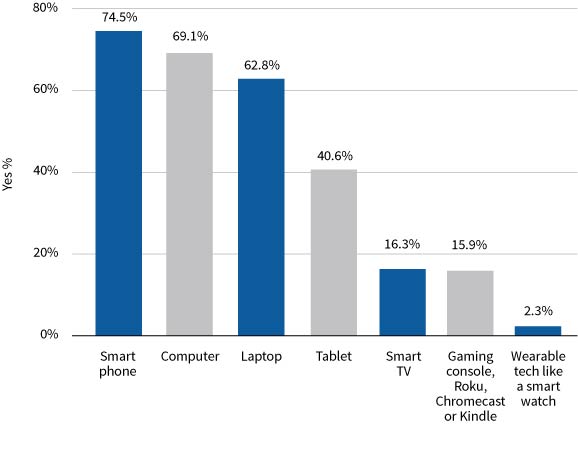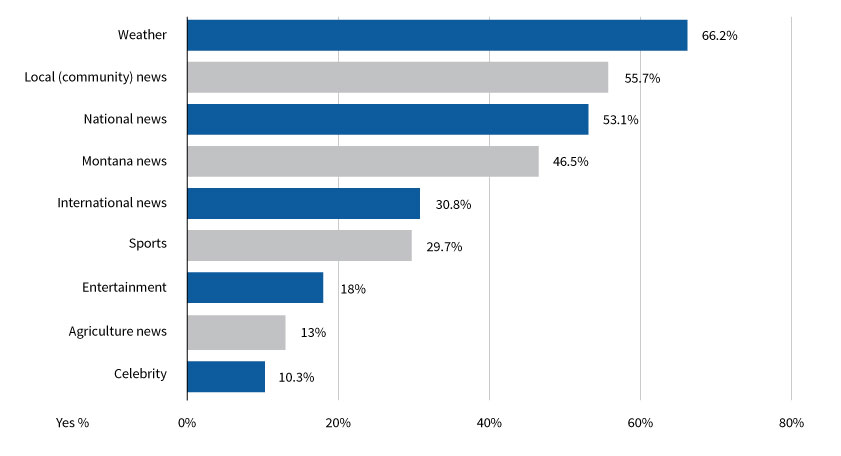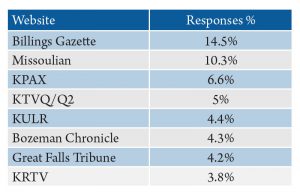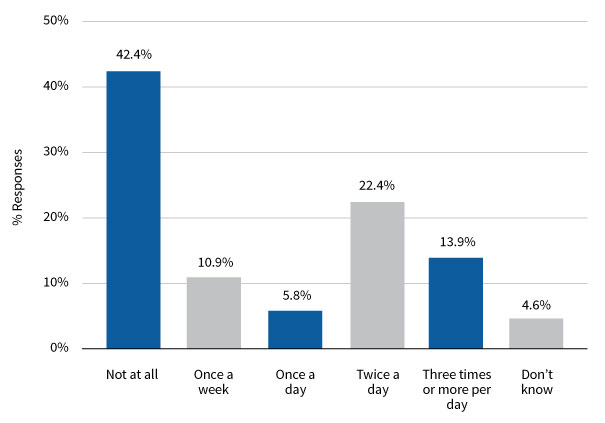Reading the morning newspaper or watching the evening news on television is becoming a bygone habit. Over the past decade, the internet has evolved to become a common tool that Montanans use to consume news – thanks largely to the rise of social media. This fundamental sea change in how we get information is having a sweeping effect on our culture – from the rise of fake news to the filter bubble that feeds and reaffirms our beliefs. As one might expect, younger people tend to use the internet more for news, while older generations fall back on traditional print and broadcast outlets. But that is changing, too.
A recent survey sponsored by the Greater Montana Foundation and conducted by the Bureau of Business and Economic Research at the University of Montana examined how Montanans get their news and the results illuminate two concerns:
The first is that the internet allows consumers to tailor their news sources and conversations, thus limiting their exposure to differing views. Some worry that reduced exposure to opposing views can erode a person’s ability to be an effective participant in their community. The second involves the endless stream of news sources and whether a person can treat them with the skepticism required to know the difference between rigorous reporting and fake news.
The internet is now a major source of news for Montanans. In 2015, 49 percent of adult Montanans reported that they got news on the internet (Figure 1). In fact, in Montana the internet is essentially tied with television as the most commonly used news source.

Surfing the internet is no longer strictly regulated to one’s desktop computer – today, the smartphone is king with nearly three-quarters (74.5 percent) of Montanans accessing the internet using this device (Figure 2).

The smartphone’s smaller screen is having an impact as well, as Montana news providers are tailoring content that can be consumed more quickly and read easily on the go.
News Websites Used by Montanans
Weather is the type of news that is most often accessed by Montanans (66.2 percent), followed by local (community) news (55.7 percent) (Figure 3).

In addition to providing a snapshot of the types of news Montanans access, the survey gave us a glimpse into which news websites were used most often. Half of the websites (50 percent) used by Montanans to obtain weather information were Montana-based. More than four-fifths of the websites (82.1 percent) used to access local news were also Montana-based and three-quarters (74.5 percent) of all websites used to gain statewide news were based in the state.
The most prominently mentioned included Montana’s largest newspapers, television stations and radio stations. Montanans most frequently used the Billings Gazette, the Missoulian, KPAX and KTVQ websites to obtain local news (Table 1).

Fox News, CNN and MSN were most often accessed by Montanans seeking national news (Table 2).

When seeking out international news, Montanans most often used the BBC, CNN and Fox News websites (Table 3).

News Access through Social Media
When consuming news via the internet, Montanans don’t always go directly to a news provider’s website, they often access it via social media, like Facebook or Twitter. In fact, a majority of adult Montanans (53 percent) reported accessing a news item through social media. Not only that, but they did so frequently – more than one in five (22.4 percent) access news through social media twice a day (Figure 4).

And here is where the plot thickens – half of Montanans who access news through social media (49.6 percent) reported they specifically follow a news provider’s website in their social media feed. The most frequently followed were FOX, CNN and the Billings Gazette (Table 4).

A significant change in placing news items on the internet has been the ability for a user to share that content with people they know. While the effects of this new channel of news distribution are not fully understood, this survey offers a first glimpse into its use in Montana.
Almost half of all adults in Montana (46.2 percent) reported that they have shared a news article in an email or on social media – most of the time it is shared with friends. And when asked about their motives for sharing, it’s most often because the item was interesting, relevant or important to them. When asked specifically whether or not they sometimes share a news item on the internet to influence others, 19.7 percent of Montanan’s said they did (Table 5).

Montanans do maintain a certain level of skepticism when they read a story that someone has shared with them, though the awareness of its credibility can differ considerably. In general, more than a third (37.9 percent) rate the news item as somewhat credible, while 16.2 percent rated it slightly credible and 5.5 percent rated it as not at all credible.
The News Echo Chamber
Two types of data highlight the concern of the news echo chamber effect – do Montanans access a news provider’s website or social media feeds that reinforces their views and do they access news shared with them by others who hold similar views? Both types of data show that some Montanans do tailor their news sources and interactions, thus limiting their exposure to differing or competing views.
The survey examined websites that Montana Republicans and Democrats reported using for national and international news in order to learn whether their choices match their politics. Table 6 shows that significant proportions of Montanans do frequently choose to obtain national news from providers that are stereotyped as matching their political party identification. The largest group of Republicans (41.7 percent) said they most frequently got national news from Fox. Similarly, 23.2 percent of Democrats said that they most frequently got national news from CNN.

A parallel pattern is evident in Table 7. Nearly one-third of Republicans reported most frequently getting international news from Fox. A similar number of Democrats (35.6 percent) reported frequently getting international news from the BBC.

To learn more about shared content, the survey examined Montanans who exchange news on the internet with like-minded people. The survey found that more than one-third of Montana’s internet users (36.3 percent) exchange news with people who hold similar views. Montana Republicans (49.4 percent) were more likely than Democrats (40 percent) or others (36.8 percent) to do this (Figure 5).

Interestingly, Montanans who have more education reported being more likely to exchange news with like-minded people than those who have less education (Figure 6).

In summary, many Montanans do tend to live in an internet news echo chamber, not only viewing stories from sources they agree with, but sharing content with like-minded friends – though they do it with some skepticism. As more Montanans get their news from social media and other Montana-based internet sources, the evidence seems to point toward a continued tailoring of these sources and interactions to match their beliefs.
This first rigorous snapshot of Montana internet news consumers’ self-reported behaviors is hardly exhaustive or conclusive. But it does suggest reasons for confidence in Montanans’ common sense, while showing signs to worry that some Montanans are tuning out differing viewpoints.

